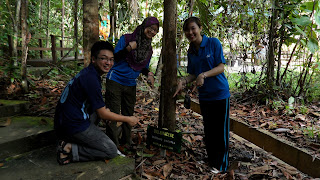THE STORY OF SIMPUR
WHAT
IS SIMPUR AND WHERE IT GROWS?
Simpur
is a distinctive shrubby tree grows vigorously on eroded soil, wasteland,
forest edges and swampy areas.
It
has large leaves and large yellow flowers. The flowers are bisexual and usually
have 5 petals. The sepals are overlapping and sometimes enlarging in fruits. It
usually open at 3 am and only last for a day. They are pollinated by bees which
collect its pollen (the flowers don't produce nectar or a scent) or by small
beetles and flies that scramble over it. Almost every flower sets fruit.
The
unopened fruits are surrounded by thick red sepals. To distinguish them from
flower buds, the fruits face upwards while flower buds face down. The ripe
fruit splits open also at 3 am, into pinkish star-shaped segments to reveal
seeds covered in red arils. The plant blooms from age 3-4 and can live for
50-100 years.
WHAT
IS THE FAMILY NAME?
The
scientific name for simpur is Dilleniaceae. The genus
is named after the German botanist Johann Jacob Dillenius, and consists
of evergreen or semi-evergreen trees and shrubs. It
is a species that can be seen in the white sands of Brunei where it serves as
the colonizer of the sands other species can not live. In due time, the white
sands will become a new rainforest.
There
are more than 100 species of Dillenia in this world, throughout the tropics. It
can be found in subtropical regions of southern Asia, Australasia, and the Indian
Ocean islands. Some examples are :
- Dillenia suffructicosa
- Dillenia alata
- Dillenia catmon
- Dillenia ingens
- Dillenia ovata
- Dillenia retusa
However,
only 15 species can be found in Brunei Darussalam. They are usually found in
the lowland, inland forests including mixed peat swamp and secondary forest to
1000 m. Examples of Dillenia found in Brunei Darusslam are :
- Dillenia beccariana (Martelli) - Borneo endemic. Locally common on the clay slopes in the lower Temburong and Batu Apoi valleys, in the Ulu Tutong and at Tasik Merimbun.
- Dillenia borneensis (Hoogland) - Found rare in Brunei: on clay soils in mixed dipterocarp forest at 300m in temburong District.
- Dillenia excelsa (jack) Gilg - Throughout Brunei especially in moist valleys and lower slopes.
- Dillenia grandifolia (Wallich) - Uncommon in Brunei : Known from Ulu Ingei and Andulau Forest reserve, Belait, and Kuala Belalong, Amo.
- Dillenia indica (Linnaeus)-Not native in Brunei:sometimes cultivated.
- Dillenia reticulata (king) - Locally frequent on sandy soils in the floodplains of the streams within Andulau Forest Reserve in Brunei, and in Ulu Belait.
- Dillenia pulchella (Jack)Gilg - Mixed peatswamp fprest and swampy kerangas, in Brunei especially near the coast.
- Dillenia suffruticosa (Griffith)martelli -Abundant on degraded land,often where covering from fire;also common in river banks and other open place,especially downriver and on poor soils.
- Dillenia sumatrana (miquel) - Common in Brunei: in lowland mixed dipterocarp forest on leached sandy and sandy clay soils-Belait and Tutong districts but far not from Temburong.
The
table below shows Dillenia species found in Brunei Darussalam.
SPECIES
|
COMMON
NAME
|
Dillenia Suffruticosa (Griffith)
Martelli
|
Simpoh Air,
Simpor Bini
Buan (Iban),
tegering abai (Murut), dingrng kala’o (Belait)
|
Dillenia
Grandifolio Wallich ex Hooker f. & Thomson
|
Pokok Simpoh Daun
Merah
|
Dillenia
Reticulata King
|
Pokok Simpoh
Gajah, simpor pay
|
Dillenia
Excelsa (Jack) Gilg
|
Pokok Simpoh
Ungu, simpor laki, simpur laki, simpoh, Simpur laki (Brunei, Dusun) Beringin (Iban)
|
Dillenia
beccariana Martelli
|
River simpor,
Buan (Iban)
|
Dillenia
Indica Linnaeus
|
|
Dillenia
Borneensis Hoogland
|
Ubah rusa
(Iban)
|
Dillenia
Sumatrana Miquel
|
Simpur Laki
(Brunei), Peru (Iban), Menterong
|
Dillenia
Pulchella (Jack) Gilg
|
Simpur paya
|
FLOWERS
OF DILLENIA : SIMPUR
Dillenia Excelsa
Dillenia Philippinensis
Dillenia suffruticosa
Dillenia Sumatrana
Dillenia Alata
Dillenia Beccariana
Dillenia Indica
FRUITS OF DILLENIA : SIMPUR
Dillenia Excelsa
 |
| Unopened fruit |
 | |||
Opened fruit
Dillenia Alata
|
 |
The open
fruit reveal bright red valves and black seeds.
|
Dillenia
indica, Dillenia speciosa
 |
The greenish-yellow fruit, which has a thick protective covering, is edible; unripe fruits are cooked to make pickle and chutney. The juicy pulp is aromatic but very acid. |
Dillenia
philippinensis
Dillenia
suffruticosa, Wormia suffruticosa
 |
The ripe fruit splits open also at 3 am, into pinkish star-shaped segments to reveal seeds covered in red arils.
It takes 5
weeks for the fruit to set.
|
Dillenia
beccariana
Unopened fruit
 | |||||||
Opened fruit
Dillenia Ingens |
Dillenia
Ovata
Dillenia
serrata, Dillenia elliptica
GENERAL USES OF
DILLENIA : SIMPUR
As an indicator of availability of water source
- This plant sends out very deep tap roots to reach underground water sources.
- Hence, some people use the plant as a guide to decide where to dig a well.
Traditional
medicinal uses
- The young shoots are used to staunch bleeding wounds.
- The fruit pulp may be used to wash the hair.
Role
in the habitat
The Simpor Bini (Dillenia suffruticosa) is also
widespread in distribution, and it can grow in various habitats.
It can be found commonly in the white sands areas,
as well in secondary growth and in swamps.
In the white sands, the Simpor Bini is a very
important species. It acts as a pioneer species, colonizing the white sands
where other tree species are unable to establish themselves on the white sands.
The Simpor Bini is known to have seeds that can
establish on the white sands, and on germinating, are able to send roots very
deep down to reach underground water source.
The low spreading shrubs that develop will
eventually provide shade for seedlings of other tree species to establish
themselves.
Islands of fresh vegetation will be initially
formed, and eventually a new forest is established.
HUNTING SIMPUR WITH FRIENDS
As mentioned earlier, simpur belongs to a genus of plants called Dillenia. The common simpur tree which can be find in Brunei Darussalam is Dillenia Suffruticosa.
Two best known and common simpur are
Dillenia Beccariana which is also known as the River Simpur and Dillenia Suffruticosa. Dillenia Suffruticosa is also well known as the Simpur
Bini. The Simpur species are usually trees, but some
can be rather shrubby.
The River Simpur (Dillenia Beccariana) is found printed on the front side of
Brunei one-dollar note. It is a small tree and it is common along the rivers, especially the Temburong River. It can be
easily observed as one takes a river journey to the Ulu Temburong
National Park. Apart from along the rivers, the River Simpor is also
found in other areas.
Dillenia Excelsa which is also known as Simpur Laki can be found in Sungai Liang Recreational Park. It is a sub-canopy tree which grows up to 25 m tall. The leaves
are alternate, simple, penni-veined and margin usually entire. The flowers are 55 mm in
diameter, yellow in colour while the fruits are 28 mm long,
red-purplish in colour with dehiscent capsule and arilate seeds.
It is found in undisturbed and secondary mixed dipterocarp forests up to 700 m altitude. Mostly on alluvial sites such as swamps and riverside. However, it is also found on hillsides and ridges, sandy to clayey soils. The timber is used for house building as it is very strong. Dillenia Excelsa can be found distributed in Thailand, Peninsular Malaysia, Sumatra, Java, Borneo (Sarawak, Brunei, Sabah, West-, Central- and East-Kalimantan), Philippines.
Below are some of the pictures of Dillenia Excelsa, Dillenia Beccariana and Dillenia Suffruticosa taken during my visit to Sungai Liang Recreational Park and Tutong with my coursemates.
* The below Simpur pictures are taken by Alice Lim*
* The below Simpur pictures are taken by Alice Lim*
 |
| Dillenia Beccariana : taken at Tutong |
 |
| The fruits |
 |
| Closer view of the fruit |
 |
| The leaves |
 |
| Leaf of Dillenia Excelsa : Picture taken at Sg Liang Recreational Park |
 |
| Hunting for Simpur |
 |
| Suspected to be Dillenia Reticulata |




















































